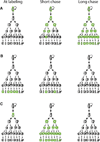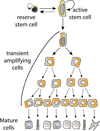Tissue stem cells: new tools and functional diversity
- PMID: 22704508
- PMCID: PMC3940056
- DOI: 10.1016/j.stem.2012.04.006
Tissue stem cells: new tools and functional diversity
Abstract
The detailed understanding of adult tissue stem cells has significance for both regenerative medicine and oncology. This perspective will discuss how major advances in our ability to identify and monitor these cells, which include genetic lineage tracing, FACS purification, and robust in vitro clonogenic assays, have changed our view of their roles in many organs. Label retention and quiescence are no longer considered obligatory stem cell features. Furthermore, some tissues have more than one type of stem cell, each used in only particular situations of regenerative stress. Thus, there is no "one size fits all" adult tissue stem cell paradigm.
Copyright © 2012 Elsevier Inc. All rights reserved.
Figures


Similar articles
-
Lung stem cells: do they exist?Respirology. 2013 May;18(4):587-95. doi: 10.1111/resp.12073. Respirology. 2013. PMID: 23433037 Review.
-
Concise Review: Human Dermis as an Autologous Source of Stem Cells for Tissue Engineering and Regenerative Medicine.Stem Cells Transl Med. 2015 Oct;4(10):1187-98. doi: 10.5966/sctm.2015-0084. Epub 2015 Aug 7. Stem Cells Transl Med. 2015. PMID: 26253713 Free PMC article. Review.
-
Somatic stem cells and tissue engineering shed light on unsolved clinical issues in reproductive medicine: in stem cells we trust.Fertil Steril. 2012 Jul;98(1):1-2. doi: 10.1016/j.fertnstert.2012.05.021. Epub 2012 May 31. Fertil Steril. 2012. PMID: 22658346
-
Endogenous lung stem cells: what is their potential for use in regenerative medicine?Expert Rev Respir Med. 2010 Jun;4(3):349-62. doi: 10.1586/ers.10.21. Expert Rev Respir Med. 2010. PMID: 20524918 Review.
-
The diversity of adult lung epithelial stem cells and their niche in homeostasis and regeneration.Sci China Life Sci. 2021 Dec;64(12):2045-2059. doi: 10.1007/s11427-020-1902-3. Epub 2021 Apr 30. Sci China Life Sci. 2021. PMID: 33948870 Review.
Cited by
-
Nanoparticle labeling identifies slow cycling human endometrial stromal cells.Stem Cell Res Ther. 2014 Jul 4;5(4):84. doi: 10.1186/scrt473. Stem Cell Res Ther. 2014. PMID: 24996487 Free PMC article.
-
Developmental Relationships of Four Exhausted CD8+ T Cell Subsets Reveals Underlying Transcriptional and Epigenetic Landscape Control Mechanisms.Immunity. 2020 May 19;52(5):825-841.e8. doi: 10.1016/j.immuni.2020.04.014. Epub 2020 May 11. Immunity. 2020. PMID: 32396847 Free PMC article.
-
S100A6 as a Constituent and Potential Marker of Adult and Cancer Stem Cells.Stem Cell Rev Rep. 2022 Dec;18(8):2699-2708. doi: 10.1007/s12015-022-10403-2. Epub 2022 Jul 7. Stem Cell Rev Rep. 2022. PMID: 35796891 Review.
-
Concise Review: A Critical Evaluation of Criteria Used to Define Salivary Gland Stem Cells.Stem Cells. 2019 Sep;37(9):1144-1150. doi: 10.1002/stem.3046. Epub 2019 Jun 19. Stem Cells. 2019. PMID: 31175700 Free PMC article. Review.
-
PDGF, NT-3 and IGF-2 in combination induced transdifferentiation of muscle-derived stem cells into Schwann cell-like cells.PLoS One. 2014 Jan 14;9(1):e73402. doi: 10.1371/journal.pone.0073402. eCollection 2014. PLoS One. 2014. PMID: 24454677 Free PMC article.
References
-
- Barker N, van Es JH, Kuipers J, Kujala P, van den Born M, Cozijnsen M, Haegebarth A, Korving J, Begthel H, Peters PJ, Clevers H. Identification of stem cells in small intestine and colon by marker gene Lgr5. Nature. 2007;449:1003–1007. - PubMed
-
- Barker N, Ridgway RA, van Es JH, van de Wetering M, Begthel H, van den Born M, Danenberg E, Clarke AR, Sansom OJ, Clevers H. Crypt stem cells as the cells-of-origin of intestinal cancer. Nature. 2009;457:608–611. - PubMed
-
- Barker N, Huch M, Kujala P, van de Wetering M, Snippert HJ, van Es JH, Sato T, Stange DE, Begthel H, van den Born M, et al. Lgr5(+ve) stem cells drive self-renewal in the stomach and build long-lived gastric units in vitro. Cell Stem Cell. 2010;6:25–36. - PubMed
-
- Burness ML, Sipkins DA. The stem cell niche in health and malignancy. Semin. Cancer Biol. 2010;20:107–115. - PubMed
Publication types
MeSH terms
Grants and funding
LinkOut - more resources
Full Text Sources

